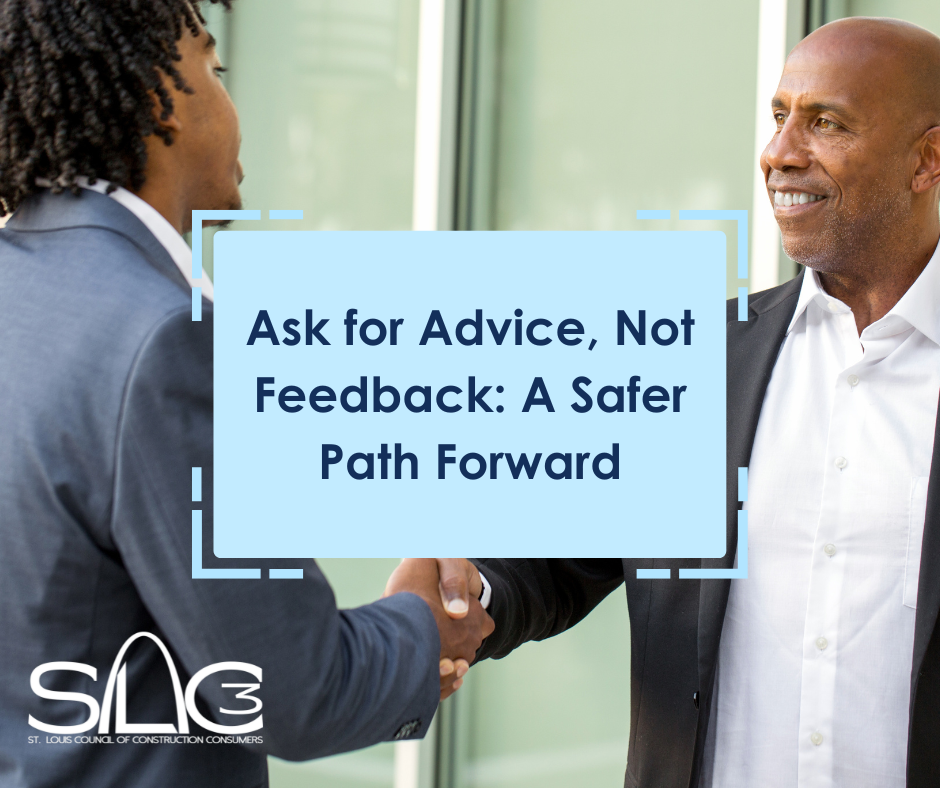I was recently reading an article in the Harvard Business Review that highlighted a simple but powerful shift: instead of asking for feedback, ask for advice. At first glance, this might seem like a minor word change, but the implications are significant — especially when it comes to safety leadership.
Blunden et al. (2025) found that when people are asked for advice, they give 34% more areas for improvement and 56% more specific ways to improve than when asked for feedback. Feedback, by contrast, often feels like a performance evaluation — backward-looking, judgmental, and vague. Advice is future-oriented, practical, and framed as guidance for improvement.
Why This Matters in Safety
In safety culture, the language we use shapes the outcomes we achieve. When a leader asks, “How did I do in that safety briefing?”, the response is often polite but unhelpful: “Not bad” or “Pretty good.” These responses ease discomfort but rarely lead to meaningful improvement.
When the question shifts to “What could I do differently in my next briefing to make the message clearer?”, the response tends to be more specific and actionable: “You could give a real example from our last outage,” or “Maybe keep it under five minutes so people stay focused.”
Peer-reviewed studies confirm that forward-looking approaches to feedback improve safety outcomes. Zhang and Li (2021) showed that employees who framed feedback seeking in terms of future consequences improved their safety performance compared with those who focused only on past actions. Likewise, Curcuruto et al. (2023) found that upward safety communication — when employees speak up about risks and leaders invite forward-focused dialogue — is strongly influenced by supervisory style. Leaders who encourage advice-oriented communication empower workers to contribute to safer practices.
The Emotional Intelligence Connection in Safety Leadership
Emotional intelligence (EI) is more than a buzzword — it is increasingly recognized as a core competency for leaders in safety-critical industries. At its foundation, EI is the ability to recognize and regulate one’s own emotions and to understand and respond to the emotions of others in ways that foster trust, collaboration, and positive outcomes (Salovey & Mayer, 1990).
In the context of safety, EI helps leaders do three things particularly well:
- Create psychological safety: Leaders with strong EI are better at creating environments where workers feel safe speaking up about risks or mistakes without fear of retaliation. This openness is vital for reporting near misses and identifying hazards before they cause harm.
- Model humility and empathy: By asking for advice rather than feedback, leaders demonstrate humility — acknowledging they don’t have all the answers — and empathy — valuing the perspectives of those doing the work. Both qualities are linked to higher safety engagement (Zhang & Li, 2021).
- Strengthening communication effectiveness: Emotionally intelligent leaders adapt their communication style to their audience. They can frame safety conversations in ways that invite collaboration instead of resistance, leading to more actionable dialogue (Curcuruto et al., 2023).
Recent studies highlight the direct connection between EI and safety performance. For instance, Jamshed et al. (2022) found that leaders who demonstrate EI skills such as active listening and empathetic engagement foster stronger safety climates and lower accident rates in industrial workplaces. Similarly, Zara et al. (2023) concluded that communication quality — one of EI’s most visible expressions — is strongly tied to safety commitment in high-risk workplaces.
Ultimately, when a leader says, “What could I do differently?” instead of “How did I do?”, they are applying EI in practice. They recognize that the emotional impact of their words influences whether others feel judged or invited into a learning process. This shift from evaluation to collaboration is at the heart of emotionally intelligent leadership — and it is one of the most effective ways to build a resilient safety culture.
Field Application
This shift can be applied across many common safety interactions:
- Post-job briefings: Instead of “How did that go?” ask, “What would you do differently if we had to do this task tomorrow?”
- Near-miss reviews: Instead of “Did I cover everything?” ask, “What would make these reviews more useful for you?”
- Peer-to-peer observations: Instead of “How did I do on that lift?” ask, “What’s one thing I could do differently to make that lift safer?”
These simple reframes change the tone from evaluation to collaboration. The worker asks for advice positions themselves as a learner, which creates space for colleagues to share without fear of offending.
Key Takeaway
Words matter in safety. When we ask for advice instead of feedback, we shift the conversation from judgment to growth. This not only leads to more specific and actionable improvements, but it also strengthens trust and engagement. In the long run, that shift may be the difference between repeating the same mistakes and building safer habits that last.
References
Blunden, H., Kristal, A., Whillans, A., Yoon, J., Burde, H., Bremner, G., & Yeomans, M. (2025). Eliciting advice instead of feedback improves developmental input (Harvard Business School Working Paper 25-047). Harvard University. https://urldefense.com/v3/__https://www.hbs.edu/ris/download.aspx?name=Eliciting*Advice*Full.pdf__;Kys!!L3YRgMg!YYLpKm_UHLHSBFVKQEUhffuzPd05dpTb3Jo7WPj8FOaoRIX4KsDX5pvwKU4DTvSPowIhBjZfRgiDhNO_5K9K$
Curcuruto, M., Lichtenstein, S., & Vlerick, P. (2023). Upward safety communication in the workplace: How team voice behaviors and supervisory styles interact. Safety Science, 164, 106170. https://urldefense.com/v3/__https://doi.org/10.1016/j.ssci.2023.106170__;!!L3YRgMg!YYLpKm_UHLHSBFVKQEUhffuzPd05dpTb3Jo7WPj8FOaoRIX4KsDX5pvwKU4DTvSPowIhBjZfRgiDhLuVv-vk$
Jamshed, S., Majeed, N., & Mustapha, I. (2022). Emotional intelligence and occupational safety performance: The mediating role of safety climate. International Journal of Environmental Research and Public Health, 19(16), 10012. https://urldefense.com/v3/__https://doi.org/10.3390/ijerph191610012__;!!L3YRgMg!YYLpKm_UHLHSBFVKQEUhffuzPd05dpTb3Jo7WPj8FOaoRIX4KsDX5pvwKU4DTvSPowIhBjZfRgiDhCBSJ8tH$
Salovey, P., & Mayer, J. D. (1990). Emotional intelligence. Imagination, Cognition and Personality, 9(3), 185–211.
Zhang, T., & Li, M. (2021). Does feedback seeking help safety performance improvement? The role of consideration of future consequence. Frontiers in Psychology, 12, 630669. https://urldefense.com/v3/__https://doi.org/10.3389/fpsyg.2021.630669__;!!L3YRgMg!YYLpKm_UHLHSBFVKQEUhffuzPd05dpTb3Jo7WPj8FOaoRIX4KsDX5pvwKU4DTvSPowIhBjZfRgiDhJEPehMS$
Zara, J., Redmill, F., & Rajab, M. (2023). A systematic literature review of communication in safety-critical workplaces: Safety communication and safety commitment. Safety Science, 161, 106086. https://urldefense.com/v3/__https://doi.org/10.1016/j.ssci.2023.106086__;!!L3YRgMg!YYLpKm_UHLHSBFVKQEUhffuzPd05dpTb3Jo7WPj8FOaoRIX4KsDX5pvwKU4DTvSPowIhBjZfRgiDhDRPQQ7-$






